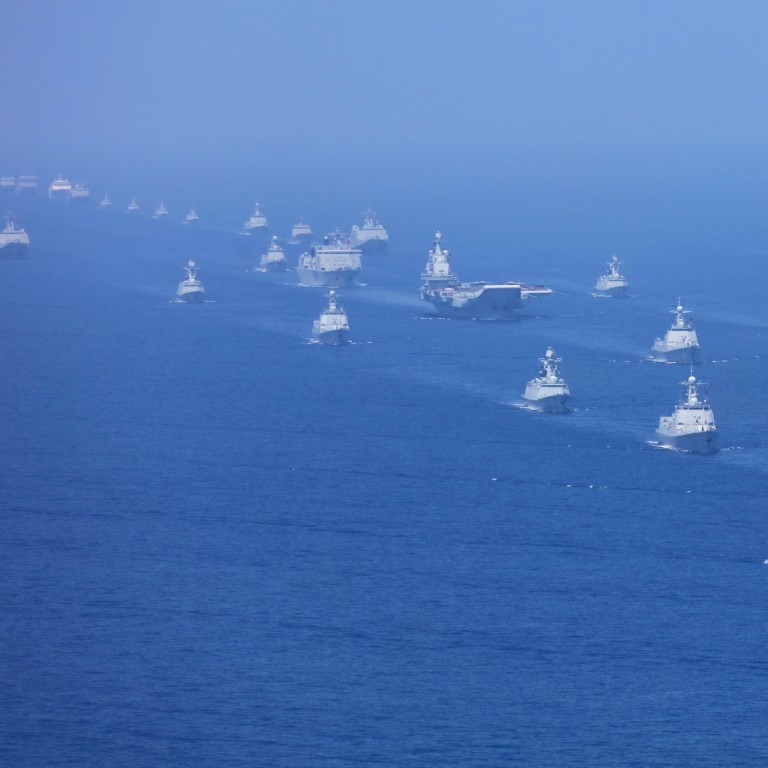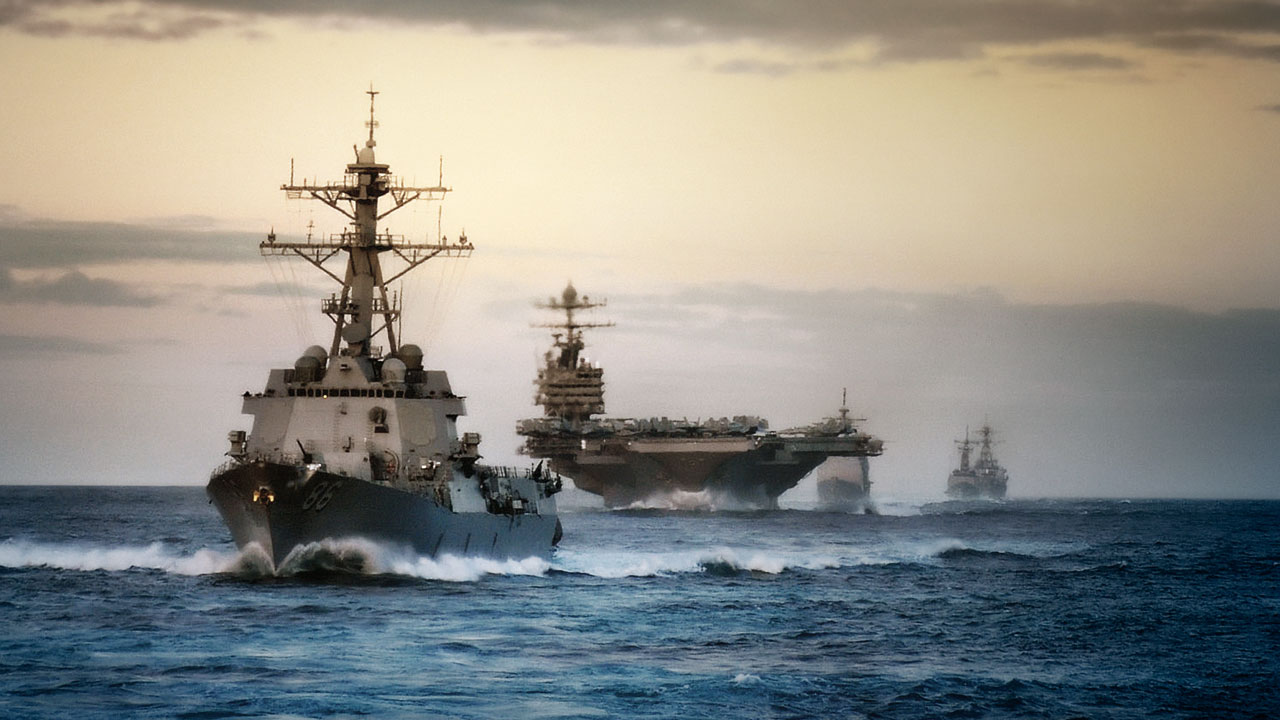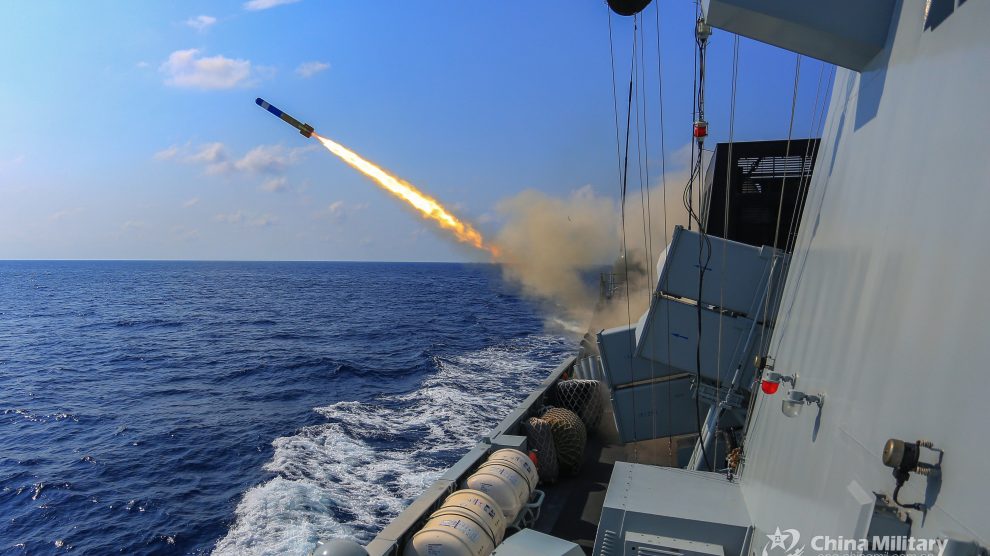 .
.
中國海軍日益強勢崛起銳不可擋多數的新式軍艦

美國海軍夕陽西下,多數為老舊的戰艦爛竽充數
美國向來以強大的海軍艦隊稱霸世界,耀武揚威的巡弋於太平洋,大西洋,印度洋及北極海域,美國從未簽署聯合國海洋公約法,而進行所謂的自由航行權.
美國依賴強勢的航空母艦戰鬥群為後盾,無止敬盡的欺壓弱小民族及國家,掠奪其資源,任意為所欲為,形同海盜打家劫舍,私毫不將國際和平放在眼內,因為美國最偉大,我們美國人說話才算數,其他國家膽敢說聲”不”字,山姆大叔的航空母艦,就假借維護世界和平的使命,巡弋到你們家附近的海域,進行軍事演習,給予警告,若是再不聽從美國的指令,就封鎖實施經濟制裁,甚至於借由實兵實彈演習,攻打你們的國家,美國食髓知味,但是自從21世紀開始,中國崛起,在中國海軍自立自強,堅苦卓絕的奮鬥,努力以赴,中國海軍由弱勢逐漸轉為強勢海軍發展,中國海軍自行設計,施工,建造,導向飛彈驅逐艦,導向飛彈護衛艦,核子動力潛艦,航空母艦,倆棲攻擊艦,補級艦,醫療船等各式各樣的軍艦,未來將自行建造核子動力航空母艦及核子動力重型巡洋艦,做為大國海軍的標準配置武器.
美國有見於此,中國海軍強勢崛起,感到不安與惶恐,因而由21世紀訂定重返亞太的戰略計劃,扼阻中國海軍,圍堵中國海軍,並且以太平洋的第一禱鏈及第二島鏈重重兵,加上飛彈網,監視中國海軍的一舉一動,同時期美國海軍的航空母艦戰鬥群,隨時隨地的任意而為,闖入中國南海,舉行軍事演習,侵犯中國主權,更進一步以實兵實彈,恐嚇中國,製造出擦槍走火的機會,好與中國海軍開戰,時間從2000年伊始至今日,將近20年的時間,中國海軍忍耐,韜光養晦,隱藏實力,發展實力,不願意正面與美國海軍開戰,直到202006-0831日這90天的局勢變化,終於讓中國海軍逮到機會,美國海軍觸犯了中國主權的底線,不僅支持台灣獨立運動,且無理的壓迫台灣,購買更多的美國淘汰性的武器,不僅價錢昂貴,基本上更不實際,浪費台灣納稅人的辛苦血汗錢,據為己有.美國的狼子野心曝露無遺.基本上就是帝國主義.
,美國海軍及空軍在20200601-0831.在中國東海,黃海,南海及台灣海峽水域的挑釁與挑戰,引起中國採取必要的反制戰略維護主權.
20200826. 中國無預警向南海發射兩枚東風導向飛彈導彈,警告美國不可輕舉妄動,協助台獨,.20200826向南中國海發射了兩枚彈道導彈,「作為對美利堅合眾國的警告」。中國人民解放軍發佈了這一消息。其中一枚DF-26B型導彈是從青海省發射的,另一枚DF21D型導彈則是從東部的浙江省發射的。兩枚導彈均射落在軍事演習封閉區域。
中國DF-26.可以精確的摧毀美國航空母艦戰鬥群,有效射程4000.KM.包括太平洋第二島鏈的關島,西方國家的軍事戰略專家評估,20200826AM:08:00.由中國本土射出的.DF-26/B.是改良型最新版.其目的主要是封鎖美國關島的軍艦與飛機.西方國家的軍事專家分析認為極可能下一次中國解放軍可能在夜間實施射擊東風導向飛彈.
美國軍方對於中國突如其來的東風飛彈射擊,徹底恐慌,由CVN-75.航空母艦戰鬥群,在20200828.零時,就全面撤出離開中國南海,因為美國知曉探測出,中國試射出的DF-21D.DF-26B.就是實彈,如果被中國瞄準鎖定美國的航空母艦與其他軍艦,攻擊後必定造成重大傷亡的慘劇,因此抹美國國防部在20200831.放出狠話假如中國以DF-21D.DF-26B.ICBM.擊沈美國的航空母艦與其他軍艦,必定以核子武器反擊中國.美國認為中國海軍的實力已經超越美國海軍,其DF-26.DF-21.可以封鎖與打擊美國關島的軍事基地,所以美國自己承認中國的關島快遞的飛彈系列,是具有絕對的吹摧毀性能力,突破美國第二島鏈的封鎖與圍堵,因此未雨綢繆美國海軍積極反制中國海軍,如此的強勢崛起,以抵抗未來與中國海軍,在太平洋的決戰,
本文的作者在探討,美國海軍是否能夠在未來與中國海軍決戰時期,是否有能力迅速置換被擊沉或是被擊毀不能繼續作戰的美國海軍艦艇.,他有遠慮的思考戰略意圖,擔心美國海軍被中國海軍擊潰,而無法即時支援置換新的軍艦繼續與中國海軍作戰.
且看北約美某大海軍退役將領的分析:
1:美國軍艦造價成本過高,建造軍艦時間過長,無法與中國軍艦的造價與3班制24小時的作業相比較.至於品質雙方雷同.
2:美國海軍雖然也就是說24小時值勤,但是管理軍紀制度,確是天高地遠的差別,只要是美國軍艦及航空母艦一旦靠岸停泊碼頭,船上除留守人員外,基本上都是下船尋花問柳,所有的美軍湧入酒吧喝醉,此外到妓院招妓尋歡,將多餘的體力與精力交給妓女,如此一來收假回到航空母艦上能夠正常值勤作業嗎?
這就充分說明出美國海軍的軍紀敗壞,影響到戰鬥力,僅有艦載機的飛行員要求嚴格,無法飲醉,招妓發泄也是有限的,所以美國航空母艦的艦載機飛行員的素質,是全世界第一名,無庸至疑,尤其是F18/A.大黃蜂戰鬥機的飛行員,他們訓練精良嚴格,可以充分發揮戰鬥力,這是須要中國海軍航空母艦的艦載機飛行員,學習效法的.中國海軍在外國執勤休假期間,嚴禁涉足不良場所,如酒吧,妓院,舞廳等情色場所,傳聞中國軍方,追隨古代軍中制度,保留”軍妓”,以供應軍隊阿兵哥的生理需求,如此一來管制得宜,至少不會像是美軍性病感染率頗高.
3:美國海軍的艦船是公開招標建造的,如沒有相當的利潤,承包商是不會投標承攬建造軍艦的,這樣一來美國福特級超級航空母艦,從開工建造50億美元,歷經6年後,竣工下水造價卻是100億美元左右,由此觀之美國海軍擴建船隻,更新軍艦,完全就是看錢辦事,否則就是罷工停擺,而且極容易洩露出造艦軍事機密,承包商握有造船資料與詳細的施工圖說,材料零組件等等軍方資料,容易被商業間諜或是軍事間諜花錢購買取得.
4:中國軍艦造船等事項,都是國營事業單位組導於執行,在工程造價,品質,進度而等方面都有嚴密的管理計劃與執行計劃,如此一來高低就判,就知道美國海軍與中國海軍的差異在何處.
5:美國海軍在海外的軍事基地,除了依賴自身的防衛外,就是必須由駐在國的軍事協助防衛,於戰爭容易被金錢收買策反,也容易被中斷供應品類的需求,因此發生實際的戰爭,對於美國海軍不利的因素,增加不易立即增兵支援作戰需求,更何況必須即時將軍艦駛往作戰地區馳援?
6:美國海軍駐守外國軍事基地,除關島,琉球,日本橫虛賀海軍基地外,是沒有家眷隨行的,因此家庭因素,影響到作戰效率,譬如駐防新加坡及歐洲的美國海軍船隻及人員,傳聞多半有同居人相伴,如此一來牽腸掛肚,無法全心全力作戰.
7:美國海軍耀武揚威要求與其盟國舉行軍事演習,多半是主角執行演習計劃,而盟國海軍只是跑龍套的配腳,真實的戰爭發生時,美國盟友海軍,多辦是聽命行事,基本上毫無戰鬥力,沒有反叛倒戈,就是感謝上帝喇.
無怪乎英國海軍評估,2030年美國海軍就是被中國海軍擊敗,其中之一的因素就是當實際戰爭發生時,美國要求盟軍支援作戰,這些國家的海軍艦艇,總是跚跚來遲,要嗎乾脆溜之大吉,躲避戰爭,因為他們知道是陪葬,打不過中國海軍,由此觀之美國海軍戰敗的確是有原因的.
8:僅管目前美國海軍太平洋艦隊的強大但是隨者時間的挪移。 美國可能會輸掉西太平洋的海戰,因為中共中國人民解放軍的海軍可以比美國海上服務更容易地再生戰鬥力。 或者更確切地說,中國龐大的工業基礎可以比美國工業更快地替代因行動而損失的硬件(船隻的備用品種)。
9:中國海軍24小時不停的訓練,有生力軍加入海軍服役,為國家犧牲奉獻,為人民服務,美國海軍除了軍官是由海軍官校培育出,其餘人員皆是商業化條件的職業軍人,他們可以解約不幹喇,另謀高就,2020 COVID-19.新冠肺炎疫病弒掠美國海軍人員,在2020年底前,傳聞美國各大航空母艦將有大量人員辭職,解約,離開海軍.如此一來在戰爭爆發期間沒有足夠的人力資源將如何與中國對戰?
10:美軍士氣的低迷,長久以來美軍不正當的執行任務,美國海軍超時工作執勤與不正當的人道對待,基層士兵,這些都已經不是軍事機密,他們不是出於自我犧牲奉獻的精神,服務於海軍,效力於海軍,不同於中國海軍官兵的團結一致,為國家,為人民,勇於犧牲奉獻生命.


強大的中國海軍勇往直前敢於開火應戰擊敗美國海軍.
USA navy old warship.
美國海軍外表顯示出強大但是實際上是脆弱的紙老虎.
China navy rise up so strong,so great.
Could the U.S. Navy Replace Ships Fast Enough in a War with China?
The United States could lose a Western Pacific naval war because Communist China’s People’s Liberation Army (PLA) can regenerate combat power more readily than the U.S. sea services can. Or, more precisely, China’s sprawling industrial base could replace hardware lost in action faster than could U.S. industry..
Among the document’s money quotes: “Replacing ships lost in combat will be problematic, inasmuch as our industrial base has shrunk, while peer adversaries have expanded their shipbuilding capacity. In an extended conflict, the United States will be on the losing end of a production race—reversing the advantage we had in World War II when we last fought a peer competitor.” This is incontestable. In the Pacific, for instance, the U.S. economy was nine or ten times the size of Japan’s. Industry was already roaring by the time the United States entered the war. After all, the nation had commenced riveting together what amounted to a second complete U.S. Navy under the Two-Ocean Navy Act of 1940. That isn’t the case today.
General Berger may sound like a Cassandra spinning lurid prophesies. But remember, the Greek god Apollo blessed Cassandra with the gift of foresight. Her prophesies were accurate. Her curse—also courtesy of Apollo, whose amorous overtures she had rebuffed—was that no one ever believed her words, no matter how prescient they were.
One hopes Commandant Berger finds a more receptive audience. His chances are better than Cassandra’s. Like the mythical soothsayer, he is no stranger to stark forecasts. Unlike her, he wields substantial authority. He can impose his views on the Marine Corps for the most part. He enjoys a bully pulpit vis-à-vis the Pentagon and Congress, and he uses it to hold forth. Almost immediately after assuming his post last summer, Berger released Commandant’s Planning Guidance that scrapped cherished shibboleths. For instance, dogma long held that the U.S. Navy must operate thirty-eight lumbering amphibious transports to ferry sea soldiers to the shores of Tripoli or other distant battlegrounds in numbers large enough to accomplish their goals. Yet large surface vessels are increasingly vulnerable to shore missile batteries, missile-armed aircraft flying from airfields on land, and submarines and surface craft sporting anti-ship missiles of their own.
Traditional ways of amphibious warfare are less and less tenable.
Rather than cling to the past, says Berger, the U.S. Marine Corps and Navy should put their trust in swarms of lighter, fleet-of-foot yet heavy-hitting craft suitable for “standing in” within the PLA’s Western Pacific weapons engagement zone. Losing a big ship constitutes a major setback for a fleet made up of a few big ships. It subtracts a major percentage from the force’s aggregate fighting power. A fleet abounding in winsome ships, by contrast, can lose one or a few in action yet fight on. Each vessel embodies only a small fraction of the fleet’s fighting strength. It is expendable.
Marine “littoral regiments” embarked in stand-in vessels will flit from island to island, lofting anti-ship and anti-air missiles the PLA’s way in a fight. If successful the joint force will seal the first island chain to Chinese maritime movement—cramping China’s export-driven economy along with the PLA’s capacity to project military power outward. They will bring some pain. Robust capability backed by obvious willpower to use it may deter Beijing. Or, should deterrence crumple, resilient capability will bolster the sea services’ prospects of prevailing in action.
Two thoughts from masters of politics and strategy, old and new. First an old commentator. Berger is making a point about U.S. grand strategy with which maritime sage Alfred Thayer Mahan would wholeheartedly agree. In the nautical realm, peacetime grand strategy means marshaling national resources to fit out ships and other implements of maritime might. Mahan catalogs the “number of population” and “character and policy of government” among six determinants of a society’s fitness for sea power. America is standing into danger if it no longer meets these Mahanian standards.
By the number of population Mahan means more than raw numbers of people. He means a society needs the right demographic mix, including a critical mass of specialists in industries relating to the sea. And so it does. Great Britain commonly outfaced France at sea during the age of sail, even though the British Isles were home to fewer citizens. Yet Britons were more plentiful in trades necessary to field merchant and naval fleets. France had to worry about land defense and, oftentimes, was ruled by kings with a penchant for offensive land warfare. Royal preferences multiplied the demands on tradesmen while distracting the kingdom from seaward ventures. As an island state with its own moat, Britain had the luxury of concentrating on marine pursuits.
Britons were fewer in numbers than the French on the whole—but they outnumbered their ancient rival in sectors that mattered.
Try a thought experiment. Mahan might ask: who is playing the role of Great Britain in the U.S.-China competition, and who is France? Mahan hoped the United States would emulate Britain, the gold standard for sea power in his day. Does it still measure up by Mahanian indices? Or perhaps Communist China is supplanting the United States by some measures. Or maybe there’s a hybrid answer. It could be that America is Britain in that it operates the better fighting fleet and that America is France in that it can no longer manufacture ships, planes, and armaments in bulk, in quick time, to replace battle casualties.
The latter conforms to Berger’s critique.
A seafaring society without a vibrant shipbuilding industry (along with aerospace firms, weapons firms, and associated trappings of modern marine strategy) is a brittle seafaring society. It cannot take a flurry of heavy blows from a peer pugilist and counterpunch for long. Even a weaker antagonist able to regain its strength swiftly after
an initial shock commands a significant advantage in a prolonged struggle. If the United States has let its sea power turn brittle, officialdom in Washington DC has soul searching to do and laws and policies to revise. The shade of Mahan would instruct them to get cracking.
Let a modern commentator have the last word. A few years ago trader and probability guru Nassim Nicholas Taleb published Antifragile, the capstone volume in a series of books investigating the nature and consequences of highly improbable events. (Among the series The Black Swan garnered arguably the most fame among military folk.) In Taleb’s parlance General Berger seems to be urging stewards of strategy to restore resiliency to the U.S. maritime sector. On the operational level, fielding resilient expeditionary forces means fielding forces that can absorb a blow, shake it off, and continue fighting. Hence the trend toward a fleet design centered more numerous platforms, none of them inordinately precious.
On the grand-strategic level, making maritime industry resilient means upgrading shipyards and other defense-related infrastructure—along with the affiliated workforce—so that stricken vessels can be repaired or replaced in a hurry. The sea services will find new staying power once industry can readily replenish matériel lost in battle. That’s what the commandant means by regenerating combat power after a tussle.
Taleb gives resiliency its due—better resilient than fragile—but he thinks it is possible to design systems that go beyond it. Resiliency implies restoring a system to the capability and capacity it boasted before absorbing damage. “Anti-fragile” systems, he postulates, can not just withstand a shock; they positively benefit from the resulting disorder. They take a heavy hit and come back better and stronger than before. How does this insight apply to fleet design? It affirms the trend toward lighter, simpler combatant and amphibious ships. If American yards can produce new generations of vessels in bulk and in haste, it may be possible to improve each generation as feedback comes in from the combat zone detailing what does and doesn’t work in action against this particular foe.
New-construction vessels will be better—and better fitted to tactical and operational circumstances—than the ones they replace.
Bottom line, General Berger may be righter than he knows about the incipient new mode of sea combat. There may be a lesson from aviation history. Think about the dizzying array of combat aircraft designed and built during World War II. New generations of warbirds replaced old in quick succession. The air arm was an anti-fragile force. But building even a technologically advanced plane is straightforward by contrast with building a massive, intricate ship of war. If ships were smaller and easier to construct—if they were more like aircraft—then manufacturing a ship would come to resemble manufacturing an airplane. Fast design improvements would become thinkable even as mass production replenished numbers of hulls. Let’s revivify the marine industrial base—and put it to work laying the keels for an anti-fragile fleet.
The commandant is a Cassandra worth heeding. The United States could lose a Western Pacific naval war because Communist China’s People’s Liberation Army (PLA) can regenerate combat power more readily than the U.S. sea services can. Or, more precisely, China’s sprawling industrial base could replace hardware lost in action faster than could U.S. industry.





















